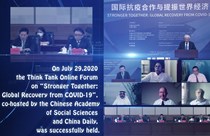Valuing the role of policy analysis in talent strategy
Author : Xue Lan Source : Chinese Social Sciences Today 2023-01-09
In the report to the 20th CPC National Congress, it is stated for the first time that “education, science and technology, and human resources are the foundational and strategic pillars for building a modern socialist country in all respects.” The report proposes to regard talent as a primary national resource, elevating China’s strategy of building a leading country of talent to a new height.
Public policy issues noteworthy
The report’s statement about deepening reform of the talent system explicitly expounds on the challenges and tasks China faces in this regard. Take the sector of artificial intelligence as an example. It can be said that China publishes the largest volume of papers on artificial intelligence in the world. Though ethnic Chinese account for a very large proportion, nearly half of the top ethnic Chinese scientists are in the US, while only one third are in China. These issues are particularly noteworthy.
Regarding the multiple challenges that talent system building faces in underpinning modernization, there are many public policy issues that need to be analyzed and solved. In the science and education sector, the major social effects that innovators can produce, and their potential, sometimes are not fully recognized by the talent market. Many institutional problems exist in the current salary system. In addition, although great importance has been attached to the talent issue and the government has promulgated a variety of targeted plans, policies, and measures, governance failures can still be found.
Empirical studies of higher education
One example is the strategic assessment of the distribution of talent resources. For many years, my research team has studied the regional distribution of higher education resources within China. At first, our team intended to find ways to narrow the gap in higher education resources between eastern and western regions, from the perspective of policy implementation, in the context of China’s Western Development Policy.
However, the research results exceeded our expectations: the spatial distribution of higher education resources in the eastern and western regions is basically consistent with the population distributions and economic levels. If population is taken as the yard stick, no serious imbalance exists in the distribution of higher education resources between eastern and western regions. In fact, several years ago we witnessed a balancing trend, with talent resources expanded towards the southwest region. Further analysis showed that the real cause of the imbalance in higher education resources is the great regional gap within each individual province or autonomous region. In reality, China’s superior higher education resources are mainly concentrated in province-level municipalities directly under the management of the Central Government and provincial capitals. The uneven distribution of higher education resources mainly exists between higher and lower-tier cities. The phenomenon is exacerbated within western regions, and less prominent within eastern regions. A case in point is the Xinjiang Autonomous Region, where most of its resources are concentrated in the city of Urumqi. These empirical studies provide a basis to solve relevant problems by means of public policies.
Micro study of talent policy
Another example is a micro study of talent policy. Here it is worth mentioning that Dr. Shi Dongbo, from Shanghai Jiao Tong University, has conducted research evaluating the effectiveness of The National Science Fund for Distinguished Young Scholars. Founded in 1994, the fund supports young scientists under age 45 who have made remarkable achievements to conduct innovative research by independently choosing their research directions. By 2014, the fund had disbursed 4.94 billion yuan to over 3000 distinguished young scientists, and disbursements for each scientist or discipline continue to increase. However, due to the increasing rate of new applicants, the proportion of approved funding actually decreased, and competition remains very fierce.
It has been observed that the effectiveness of sponsored scientists in research and their abilities to innovate are substantially affected by the fund. From the perspective of policy studies, several findings are particularly significant. First, there is an inverted U-shaped relationship between scientists’ funding scale and research output. Therefore, if funding levels continue to rise beyond a certain level, the impact on scientists’ output is negative. It is not simply a linear relationship. The reason is perhaps that the greater the funding, the more likely it is for administrative costs to increase, while career incentives for scientists, however, are likely to decline. This shows that accurate targeted policy research can help us determine the focal point of public policies.
The above research shows that there are many pertinent public policy issues that correlate with the strategy of building China into a leading talent country, but the current analysis and evaluation of these issues are far from sufficient. To strengthen the role of modern talent in underpinning modernization in the future, intuition should not be solely adopted to solve problems. Approaches from public policy perspectives need to be used for analysis and evaluation in a systematic way.
Xue Lan is a professor and dean of the Schwarzman Scholars at Tsinghua University.
Ye Shengtao made Chinese fairy tales from a wilderness
Ye Shengtao (1894–1988) created the first collection of fairy tales in the history of Chinese children’s literature...
-
How northern ethnicities integrated into Chinese nation
2023-09-18
-
Mogao caves
2023-09-12
-
Mogao Grottoes as ‘a place of pilgrimage’
2023-09-12
-
Time-honored architectural traditions in China
2023-08-29
-
Disentangling the civilizational evolution of China
2023-08-28
-
AI ethics in science fiction
2023-08-23














 2011-2013 by www.cssn.cn. All Rights Reserved
2011-2013 by www.cssn.cn. All Rights Reserved